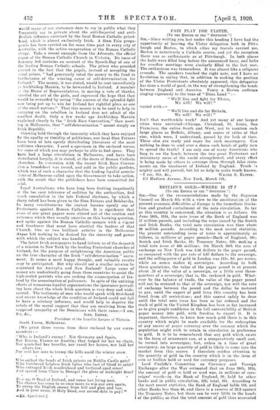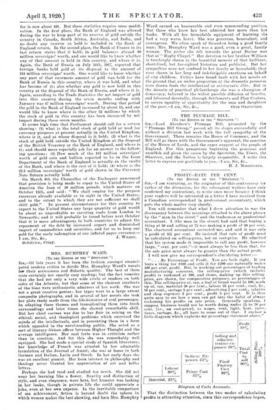BRITAIN'S GOLD.—WHERE IS IT
[To THE EDITOR OF THE " SPECTATOR29 SIR,—One of the recommendations made by the Supreme Council on March 8th with a view to the amelioration of the present economic difficulties of Europe is the immediate limita- tion and gradual curtailment of the note circulation. So far as this country is concerned, the situation is as follows. On June 30th, 1914, the note issue of the Bank of England was 57 million pounds, and including the notes issued by the Scotch and Irish Banks, the total note circulation was then about 80 million pounds. According to the most recent statistics, the present outstanding issue of notes is approximately as follows, in millions of paper pounds—Bank of England, 101; Scotch and Irish Banks, 59; Treasury Notes, 328; making a total note issue of 488 millions. On March 10th the rate of exchange on New York was 3.58 dollars to the paper pound, as compared with the par rate of 4.87 dollars to the sovereign, and the selling-price of gold in London was 111s. 9d. per ounce, while an ounce makes 41 sovereigns. According to both these quotations, the value of the paper pound is at present about .76 of the value of a eovereign, or a little over three- quarters of a sovereign; that is, 15s. reckoned in gold. What- ever be the balance of trade, the value of the paper pound will not be restored to that of the sovereign, nor will the rate of exchange between the pound and the dollar be restored to par, until the export of gold from this country has been freed from all restrictions; and this cannot safely be done until the total note issue has been so. far reduced and the stock of gold in the United Kingdom has been so far increased as to give people confidence in the full convertibility of British paper money into gold, with freedom to export it. It is important, therefore, to know how much gold there is in this country which might be made available for the redemption of any excess of paper currency over the amount which the population might wish to retain in circulation in preference to gold. It is to be remembered that any gold which exists in the form of ornaments can, at a comparatively small cost, be turned into sovereigns; but, unless in a time of great emergency, no large quantity of gold is likely to come into the market from this source. I therefore confine attention to the quantity of gold in. the country which is in the form of coin or bullion held or used for currency purposes.
Lord Cunliffe's Committee on Currency and Foreign Exchanges after the War estimated that on June 30th, 1914, the amount of gold so held or used was, in millions of sove- reigns' worth—in the Bank of England, 38; held by other banks and in public circulation, 123; total, 161. According to the most recent statistics, the Bank of England holds 113, and other Banks less than 40, and there is a reserve of 28.5 against the Treasury Notes, but there can be very little in the hands of the public; so that the total amount of gold thus accounted for is now about 181. But these statistics require some modifi- cation. In the first place, the Bank of England was allowed during the war to keep part of its reserve of gold outside the
country in Canada, South Africa, Australia, and India, and no doubt any reserve ED held is included in the Bank of :England return. In the second place, the Bank of France in its last return states that it holds in gold balances abroad 80
million sovereigns' worth, and one would like to know whether any of that amount is held in this country, and where it is. Again, the Bank of Russia on July 16th, 1917, reported that foreign banks held gold at its disposal to the amount of 244 million sovereigns' worth. One would like to know whether any part of that enormous amount of gold was held for the Bank of Russia in this country, where it was held, and what has become of it; also whether any gold is now held in this country at the disposal of the Bank of Russia, and where it is. Again, according to the Trade Statistics the net import of gold into this country during the seven months ending with January was 47 million sovereigns' worth. During that period the gold in the Bank of England increased by about 15, and one would like to know where is the other 32 millions by which the stock of gold in this country has been increased by net import during those seven months.
It seems high time that Parliament should call for a return showing : (1) what is the total stock of gold held or used for currency purposes at present actually in the United Kingdom, where is it, and at whose disposal is it held; (2) what is the stock of gold held outside the United Kingdom at the disposal of the British Treasury or the Bank of England, and where is it; and should more especially ask for an answer to the folio*. ing questions: (3) How much of the 113 million sovereigns' worth of gold coin and bullion reported to be in the Issue Department of the Bank of England is actually in the vaults of the Bank, and where is the rest of it held; (4) where is the 28.5 million sovereigns' worth of gold shown in the Currency Note Return actually held.
On March 8th the Chancellor of the Exchequer announced that provision is being made to repay to the United States of America the loan of 50 million pounds which matures on October 15th, and said: "We shall employ for the purpose resources already available or in sight in the United States; and to the extent to which they are not sufficient we shall shift gold." In present circumstances for this country to export to the United States any large quantity of gold would be about as unprofitable as carrying coals from London to Newcastle; and it will probably be found before next October that it is more advantageous to both countries to adjust the repayment of the debt by increased export and diminished import of commodities and securities, and for us to keep our gold for the early redemption of our inflated paper currency.—



































 Previous page
Previous page